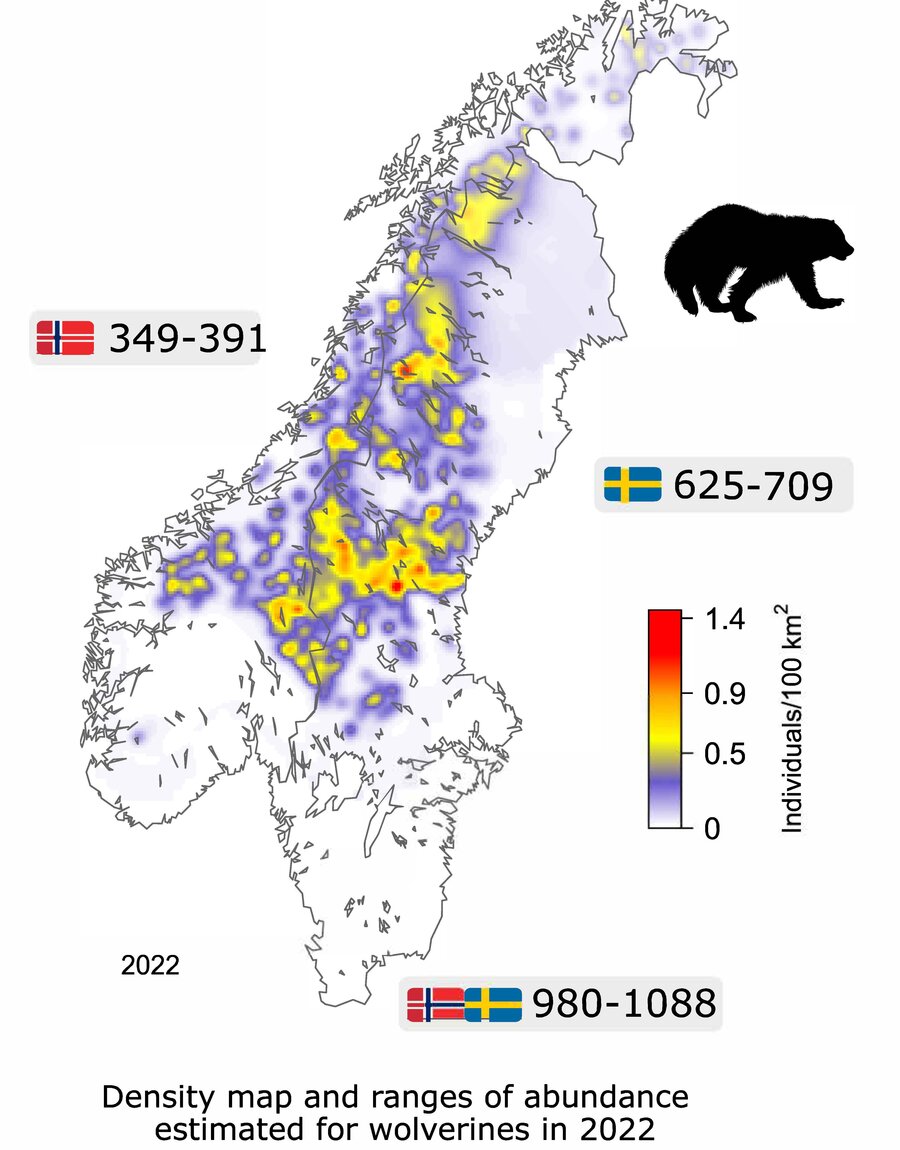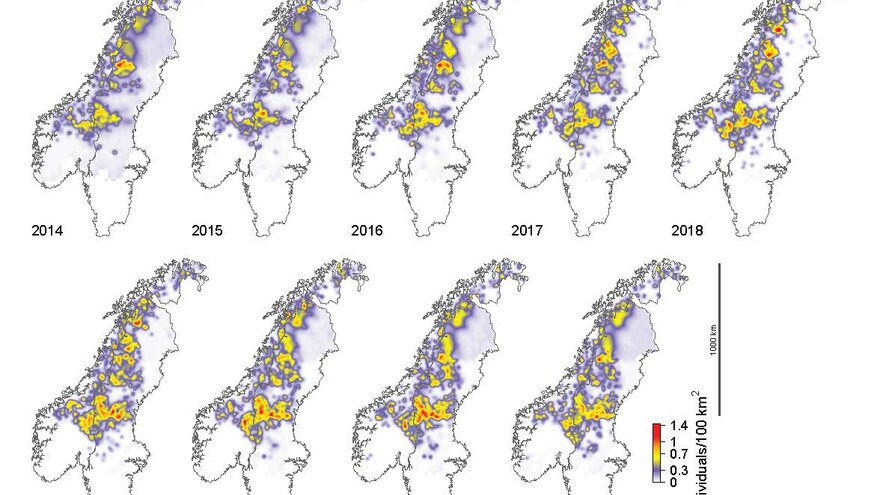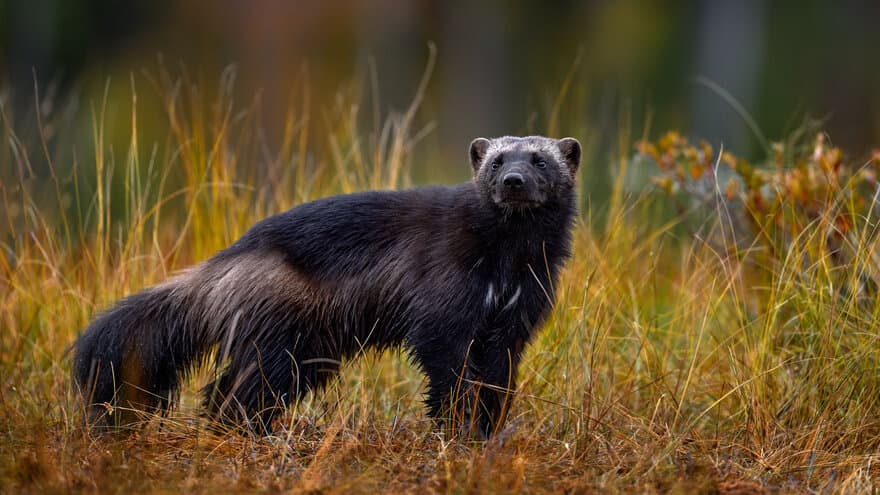NMBU’s researchers present the most recent wolverine population estimates and maps for Scandinavia.
The wolverine is a symbol of wilderness throughout the northern hemisphere. Researchers from the Norwegian University of Life Sciences (NMBU) have just published the latest results from a large international monitoring project.
“Instead of just numbers, we create maps of large carnivore populations, like the wolverine.” says Cyril Milleret, researcher at NMBU and first author of the report.
“Maps are much more useful than just numbers, as they tell us where and how many”, explains Milleret. “This information gives wildlife managers a more comprehensive picture of the population.”
A Norwegian-Swedish-population
“This winter we estimate that the total size of the Scandinavian wolverine populations is between 980 and 1088 individuals,” Milleret says.
This is a slight decrease from last year, when the population was estimated to range between 1028 and 1115 wolverines.
This year’s map and population size estimates are just the latest in a 9-year time series. The population has been growing slightly over this period, but a closer look reveals that this is due to population growth in Sweden. The Norwegian population has remained stable.

Animals do not see borders
It is difficult separating the animals into nationalities. Wolverines on both sides of the border are part of the same population; in fact, many individuals spend time in both countries. This is why transnational monitoring and analysis are so important.
Milleret points out:
“Instead of just a single population size estimate, we provide a range of values that likely contains the real number of wolverines in Scandinavia.”
“We want to make managers, policy makers, and the public aware that model-derived estimates are always uncertain.”

Wildlife populations as surfaces
“Wildlife populations are not simply piles of animals”, adds NMBU professor Richard Bischof, leader of the research team and co-author of the report.
“We think, it is more useful to think of wildlife populations as surfaces draped across the landscape: there are places with higher densities, places with lower densities or even areas without animals.”
“Knowing what that surface looks like and how it changes over time, will help us better understand how animals interact with their environment”.
For example, a map of the density of large carnivores could inform about the predation risk to livestock. Or it could reveal areas of unusually low densities that warrant a closer look at potential threats.
National and international collaboration
NMBU-led project RovQuant provides quantitative information and tools for improved monitoring and management of large carnivores in Scandinavia. The team is collaborating with wildlife managers and researchers in Norway, Sweden, the USA, Germany, and Italy. Rovdata at the Norwegian Institute for Nature Research, and wildlife management agencies in Norway and Sweden are key partners.
The work is funded by the Norwegian Environment Agency, the Swedish Environmental Protection Agency, and the Research Council of Norway.
The results are published in the report "Estimates of wolverine density, abundance, and population dynamics in Scandinavia, 2014-2022". The report can be downloaded for free via ResearchGate here (ekstern link).
Visit the project page (RovQuant) hereVisit the research group Applied quantitative ecology group (AQEG) heregithub: Public repository for sharing material associated with Scandinavian carnivore spatial capture-recapture (SCR) analyses conducted via the projectThe wolverine is a symbol of wilderness throughout the northern hemisphere. Researchers from the Norwegian University of Life Sciences (NMBU) have just published the latest results from a large international monitoring project.
“Instead of just numbers, we create maps of large carnivore populations, like the wolverine.” says Cyril Milleret, researcher at NMBU and first author of the report.
“Maps are much more useful than just numbers, as they tell us where and how many”, explains Milleret. “This information gives wildlife managers a more comprehensive picture of the population.”
A Norwegian-Swedish-population
“This winter we estimate that the total size of the Scandinavian wolverine populations is between 980 and 1088 individuals,” Milleret says.
This is a slight decrease from last year, when the population was estimated to range between 1028 and 1115 wolverines.
This year’s map and population size estimates are just the latest in a 9-year time series. The population has been growing slightly over this period, but a closer look reveals that this is due to population growth in Sweden. The Norwegian population has remained stable.

Animals do not see borders
It is difficult separating the animals into nationalities. Wolverines on both sides of the border are part of the same population; in fact, many individuals spend time in both countries. This is why transnational monitoring and analysis are so important.
Milleret points out:
“Instead of just a single population size estimate, we provide a range of values that likely contains the real number of wolverines in Scandinavia.”
“We want to make managers, policy makers, and the public aware that model-derived estimates are always uncertain.”

Wildlife populations as surfaces
“Wildlife populations are not simply piles of animals”, adds NMBU professor Richard Bischof, leader of the research team and co-author of the report.
“We think, it is more useful to think of wildlife populations as surfaces draped across the landscape: there are places with higher densities, places with lower densities or even areas without animals.”
“Knowing what that surface looks like and how it changes over time, will help us better understand how animals interact with their environment”.
For example, a map of the density of large carnivores could inform about the predation risk to livestock. Or it could reveal areas of unusually low densities that warrant a closer look at potential threats.
National and international collaboration
NMBU-led project RovQuant provides quantitative information and tools for improved monitoring and management of large carnivores in Scandinavia. The team is collaborating with wildlife managers and researchers in Norway, Sweden, the USA, Germany, and Italy. Rovdata at the Norwegian Institute for Nature Research, and wildlife management agencies in Norway and Sweden are key partners.
The work is funded by the Norwegian Environment Agency, the Swedish Environmental Protection Agency, and the Research Council of Norway.
The results are published in the report "Estimates of wolverine density, abundance, and population dynamics in Scandinavia, 2014-2022". The report can be downloaded for free via ResearchGate here (ekstern link).
Visit the project page (RovQuant) hereVisit the research group Applied quantitative ecology group (AQEG) heregithub: Public repository for sharing material associated with Scandinavian carnivore spatial capture-recapture (SCR) analyses conducted via the project